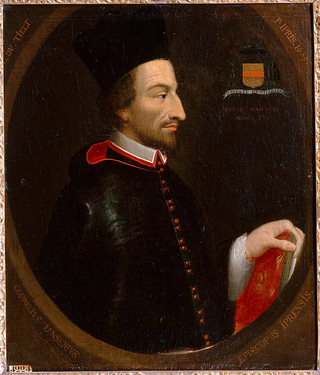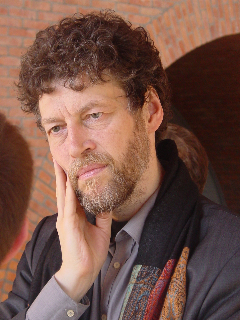Related Research Articles

Jansenism was an early modern theological movement within Catholicism, primarily active in the Kingdom of France, that arose in an attempt to reconcile the theological concepts of free will and divine grace. Jansenists claimed to profess the true doctrine of grace as put forth by Augustine of Hippo. In 1653, Pope Innocent X promulgated the bull Cum occasione, which condemned five errors attributed to Janesenism, including the idea that Christ did not die or shed his blood for all men.

Dzongkha is a Sino-Tibetan language that is the official and national language of Bhutan. It is written using the Tibetan script.

The Université catholique de Louvain is Belgium's largest French-speaking university. It is located in Louvain-la-Neuve, which was expressly built to house the university, and Brussels, Charleroi, Mons, Tournai and Namur. Since September 2018, the university has used the branding UCLouvain, replacing the acronym UCL, following a merger with Saint-Louis University, Brussels.

Eight Deer Jaguar Claw, or 8 Deer for brevity, was a powerful Mixtec ruler in 11th-century Oaxaca referred to in the 15th-century deerskin manuscript Codex Zouche-Nuttall, and other Mixtec manuscripts. His surname is alternatively translated Tiger-Claw and Ocelot-Claw. John Pohl has dated his life spanning from 1063 until his sacrifice in 1115. Consonant with standard Mesoamerican practice, the "Eight Deer" component of his name refers to his day of birth within the 260-day Mesoamerican cycle, which cycles through 13 numbers and 20 various signs.

Karl Andreas Taube is an American Mesoamericanist, Mayanist, iconographer and ethnohistorian, known for his publications and research into the pre-Columbian cultures of Mesoamerica and the American Southwest. As of 2009 he holds a position as Professor of Anthropology at the College of Humanities, Arts, and Social Sciences, University of California, Riverside. In 2008 he was named the College of Humanities, Arts, and Social Sciences distinguished lecturer.
Joyce Marcus is a Latin American archaeologist and professor in the Department of Anthropology, College of Literature, Science, and the Arts at the University of Michigan, Ann Arbor. She also holds the position of Curator of Latin American Archaeology, University of Michigan Museum of Anthropological Archaeology. Marcus has published extensively in the field of Latin American archaeological research. Her focus has been primarily on the Zapotec, Maya, and coastal Andean civilizations of Central and South America. Much of her fieldwork has been concentrated in the Valley of Oaxaca, Mexico. She is known for her "Dynamic model", four-tiered hierarchy, and her use of interdisciplinary study.
Ross Hassig is an American historical anthropologist specializing in Mesoamerican studies, particularly the Aztec culture. His focus is often on the description of practical infrastructure in Mesoamerican societies. He is the author of several influential books, among them: Time, History, and Belief in Aztec and Colonial Mexico; Aztec Warfare: Imperial Expansion and Political Control; and Trade, Tribute, and Transportation: The Sixteenth-Century Political Economy of the Valley of Mexico.
Robert J. Sharer was an American archaeologist, academic and Mayanist researcher. He was known for his archaeological investigations at a number of pre-Columbian Mesoamerican sites conducted over a career spanning four decades, and for his archaeological reports, theorizing, and writings in his field of specialty, the ancient Maya civilization. Sharer was a lecturer and professor at the University of Pennsylvania's Department of Anthropology for more than 30 years, and as of 2008 occupied the endowed chair of Sally and Alvin V. Shoemaker Professor in Anthropology, an appointment which he held beginning in 1995. He also had an extensive association with Penn's University Museum of archaeology and anthropology, where from 1987 to 2009 he was the curator-in-charge of the Museum's American collection and research section. He died on September 20, 2012.
Richard A. Diehl is an American archaeologist, anthropologist and academic, noted as a scholar of pre-Columbian Mesoamerican cultures. He is particularly renowned for his extensive contributions in the study of the Olmec civilization, which flourished in the Gulf Coast of Mexico region during the Formative period in Mesoamerican chronology and widely influenced subsequent Mesoamerican cultures. Diehl retired from formal academia at the end of the 2007 academic year, after a career spanning over four decades. He retained title as Professor Emeritus in the Department of Anthropology at the University of Alabama (UA), Tuscaloosa. Post-retirement Diehl continues to be active in Mesoamerican and archaeological research, teaching classes and authoring publications on the Olmec and other archaeological subjects.
Yahui is a supernatural figure that takes on various mixtures of animal and human forms within the culture and belief systems of the Mixtec—indigenous Mixtecan-speaking people of La Mixteca in central-southeastern Mexico. It is an important and recurring motif in Mixtec iconography, thought and culture, especially during the pre-Columbian era. As a supernatural figure, the yahui appears in Postclassic Mixtec codices as an entity wearing a serpent or reptilian tail and headdress and the carapace of a turtle.

Richard E. Blanton is an American anthropologist, archaeologist, and academic. He is most renowned for his archaeological field and theoretical research into the development of civilizations in pre-Columbian Mesoamerica, particularly those from the central Mexican plateau and Valley of Oaxaca regions. Blanton taught at Rice University and Hunter College of the City University of New York before joining the faculty at Purdue University in 1976. He is currently Professor Emeritus of Anthropology at Purdue's College of Liberal Arts.
The University of Ioannina is a university located 5 km southwest of Ioannina, Greece. The university was founded in 1964, as a charter of the Aristotle University of Thessaloniki and became an independent university in 1970.
Arthur G. Miller is an American art historian, archaeologist and academic. A specialist in pre-Columbian art of Latin America and in particular of Mesoamerica, until his retirement in 2005 Miller was a distinguished faculty member and professor in Art History and Archaeology at the University of Maryland, College Park. Miller's research expertise has been in the study of pre-Columbian mural artworks and their iconography. He has published numerous academic papers and books on the mural art of Mesoamerican cultures, such as Classic-era Teotihuacan of central Mexico, Zapotec tombs and sites in Oaxaca, and Maya sites along the eastern coastline of the Yucatán Peninsula.
Vernon Lee Scarborough is an American academic anthropologist and archaeologist, known for his research and publications on settlement, land use and water management practices of archaic and Pre-industrial society.

H.W.A. (Henk) Blezer is a Dutch Tibetologist, Indologist, and scholar of Buddhist studies.
Susan D. Gillespie is an American academic anthropologist and archaeologist, noted for her contributions to archaeological and ethnohistorical research on pre-Columbian Mesoamerican cultures, in particular the Aztec, Maya and Olmec. As of 2009 Gillespie holds a position as professor in the Department of Anthropology at University of Florida, Gainesville, USA, having also been associate chair of the department from 2003 until 2009.

Arlen F. Chase is a Mesoamerican archaeologist and a faculty member in the anthropology department at Pomona College, Claremont CA. Previously, he was a professor at the University of Nevada, Las Vegas and served a variety of administrative roles at the University of Central Florida over the course of his 32 year stay at that institution. He is noted for his long-term research at the ancient Maya city of Caracol, Belize and for exploring landscape traces of Maya civilization using lidar.
Dr. Jan Jansen of Leiden University, Netherlands, is a historian and anthropologist specialising in the oral history of sub-Saharan Africa, particularly Mali.

Pieter Johannes Veth was a Dutch professor of geography and ethnology and the first Chairman of the Royal Netherlands Geographical Society. He was also the father of Daniël David Veth, a Dutch explorer and photographer.
Willemina Zwanida "Willeke" Wendrich is a Dutch and/or American Egyptologist and archaeologist.
References
- CNWS Research School (n.d.). "Prof. dr. M.E.R.G.N. Jansen". School of Asian, African and Amerindian Studies. Leiden University. Retrieved 2007-08-21.